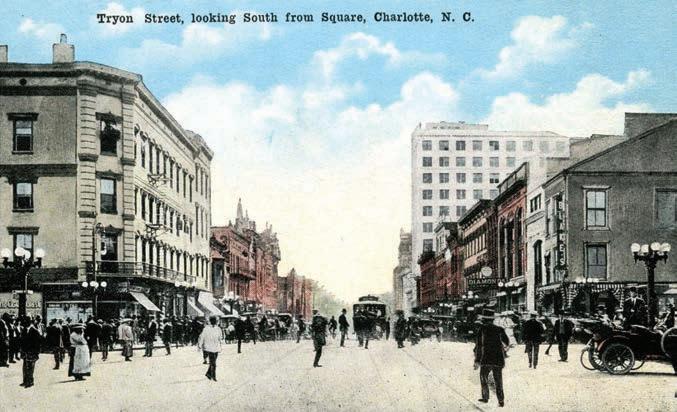
3 minute read
Hot Listings
By the 1920s, some down/uptown structures soared 10 stories or more.
lively.” It appeared frequently thereafter. 1889: “A Daring Burglary” occurred while Mrs. S.C. Bryan “was uptown buying some garments.” 1897: The Southern Railway opened “an uptown ticket o ce on Tryon Street.”
That proves that “uptown” is no recent invention. It came into use just before 1900, when people needed a word to refer to Charlotte’s newly dense cluster of business buildings around Trade and Tryon.
But what about “downtown”? It rst showed up on June 9, 1906, nearly 20 years a er the runaway streetcar article: a report of a passing blimp, rare at the dawn of manned ight. “The gentleman who made the discovery has a room downtown.” So “uptown” has deeper roots.
Charlotteans continued to use both terms, with “uptown” much more frequent. 1908: Ringling Brothers Circus opened a “downtown ticket o ce.” 1911: “Uptown District … Has Fi y Electric Signs.” 1912, an ad: “Central Hotel, uptown, plenty of good things to eat.” 1914: “Remodeling Under Way on Several Downtown Buildings.” 1930: “Council Adopts Parking Rules in Uptown.”
The peaceful coexistence ended in 1959. Merchants, led by department store magnates George Ivey and John Belk, founded an Uptown Charlotte Association to battle suburban competition. But even then, Charlotte had lots of newcomers, and where they’d come from, “downtown” connoted “business district.” The organization pivoted: “Publicity lends itself to downtown,” explained M.W. Crosland of the rechristened Downtown Charlotte Association.
Some old-line Charlotteans wouldn’t let the matter rest, though. Jack Wood, owner of a South Tryon Street clothing shop, mounted an “uptown” campaign in the early 1970s and won sanction from the city government. On Sept. 23, 1974, as recorded in City Council minutes, Mayor John Belk presented Wood and his allies “with a proclamation designating [the] central shopping center and business area as ‘UPTOWN CHARLOTTE.’”
So, is the debate settled? “Uptown” has longer tenure and the city’s o cial approval—but there’s historical precedent to call it “downtown” if you wish. Either way, visit, and bring some money to spend.
BUILDING HISTORY is a monthly series that highlights Charlotte’s historic buildings. Tom Hanchett, a local historian since 1981, is the author of Sorting Out the New South City: Race, Class, and Urban Development in Charlotte and former sta historian at the Levine Museum of the New South. Follow him on Twitter at @historysouth.
REAL ESTATE Hot Listings
Ritzy residences in Charlotte’s golf course communities. —Taylor Bowler

14109 BALLANTYNE COUNTRY CLUB DRIVE $1,100,000 BALLANTYNE Enjoy views of the h hole from this charming English-inspired manor. The main level has a great room with a wood-burning stone replace, plus an o ce, exercise studio, chef’s pantry, and dedicated laundry room. 5 BD, 5 BA, 4,308 sq. ., Helen Adams Realty, helenadamsrealty.com
4701 PIPER GLEN DRIVE $2,335,000 PIPER GLEN Live on the #7 fairway in this sprawling French Country estate. The gourmet kitchen has custom cabinetry, a 12-foot island, and a spacious eating area with bay windows. On the lower level, enjoy a full bar, movie theater, exercise room, and wine cellar. 5 BD, 7 BA, 9,051 sq. ., Coldwell Banker, coldwellbanker.com
2826 SHARON ROAD $2,051,000 MYERS PARK This .75-acre lot overlooks the sixth hole of Myers Park Country Club. The rst- oor primary suite has a spa-like bathroom, dual walk-in closets, replace, and access to the rear terrace. 5 BD, 6 BA, 4,778 sq. ., The McDevitt Agency, themcdevittagency.com
16627 FLINTROCK FALLS LANE $598,800 STEELE CREEK This classic brick home in the gated Eagle’s Landing neighborhood has a fenced backyard that faces the 15th hole of the Palisades Golf Course. A spindle staircase in the two-story foyer leads to four bedrooms and a bonus room. 4 BD, 4 BA, 3,420 sq. ., Allen Tate, allentate.com











